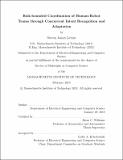Risk-bounded coordination of human-robot teams through concurrent intent recognition and adaptation
Author(s)
Levine, Steven James.
Download1102048633-MIT.pdf (10.05Mb)
Other Contributors
Massachusetts Institute of Technology. Department of Electrical Engineering and Computer Science.
Advisor
Brian C. Williams.
Terms of use
Metadata
Show full item recordAbstract
There is an ever-growing demand for humans and robots to work fluidly together in a number of important domains, such as home care, manufacturing, and medical robotics. In order to achieve this fluidity, robots must be able to (1) recognize their human teammate's intentions, and (2) automatically adapt to those intentions in an intelligent manner. This thesis makes progress in these areas by proposing a framework that solves these two problems (task-level intent recognition and robotic adaptation) concurrently and holistically, using a single model and set of algorithms for both. The result is a mixed-initiative human-robot interaction that achieves the team's goals. The robot is able to reason about the action requirements, timing constraints, and unexpected disturbances in order to adapt intelligently to the human. We extend this framework by additionally maintaining a probabilistic belief over the human's intentions. We develop a risk-aware executive that performs concurrent intent recognition and adaptation. Our executive continuously assesses the risk associated with plan execution, selects adaptations that are safe enough, asks uncertainty-reducing questions when appropriate, and provides a proactive early warning of likely failure. Finally, we present an extension to this work which enables the robot to save time by ignoring potentially many, vanishingly-unlikely scenarios. To achieve this behavior, we frame concurrent intent recognition and adaptation as a constraint satisfaction problem, and compactly represent their associated solutions and policies using compiled structures that are updated online as new observations arise. Through the use of these compiled structures, the robot efficiently reasons about which actions to perform, as well as when to perform them - thereby ensuring decision making consistent with the team's goals.
Description
This electronic version was submitted by the student author. The certified thesis is available in the Institute Archives and Special Collections. Thesis: Ph. D., Massachusetts Institute of Technology, Department of Electrical Engineering and Computer Science, 2019 Cataloged from student-submitted PDF version of thesis. Includes bibliographical references (pages 369-378).
Date issued
2019Department
Massachusetts Institute of Technology. Department of Electrical Engineering and Computer SciencePublisher
Massachusetts Institute of Technology
Keywords
Electrical Engineering and Computer Science.